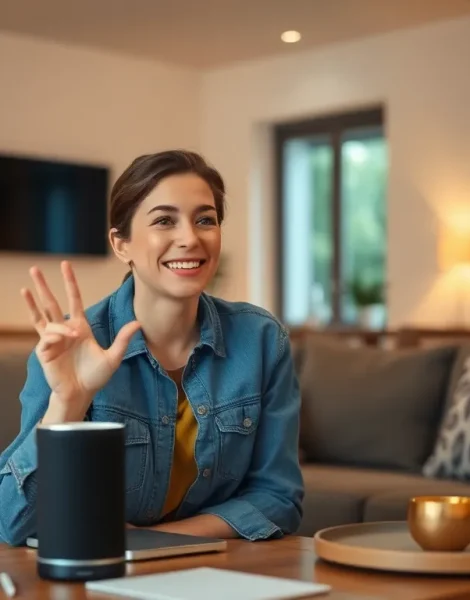Imagine a world where your commands are met with instant action, where asking your home to dim the lights feels like having a personal assistant at your beck and call. Voice-controlled tech isn’t just a futuristic fantasy; it’s here, and it’s making everyday life a whole lot easier. From smart speakers that play your favorite tunes to virtual assistants that manage your schedule, this technology is changing the game.
But let’s be honest—who hasn’t had a hilarious moment when their device misinterpreted a command? Whether it’s ordering a pizza and ending up with a llama, or asking for a weather update and getting a lecture on the history of umbrellas, voice tech keeps things entertaining. With advancements rolling in faster than you can say “Hey Siri,” it’s time to explore how this quirky tech is reshaping our homes and lives, one voice command at a time.
Table of Contents
ToggleOverview of Voice-Controlled Tech
Voice-controlled technology has transformed how individuals interact with devices. This type of technology relies on natural language processing, allowing users to issue commands through speech. Smart speakers, such as Amazon Echo and Google Home, exemplify this innovation by enabling hands-free management of tasks.
Businesses integrate voice tech into customer service solutions to enhance user experiences. Chatbots and virtual assistants respond to inquiries efficiently, streamlining communication. Industry research shows that approximately 35% of households use voice-activated devices, illustrating widespread acceptance.
Managing smart home devices has become more intuitive with voice commands. Users can control lights, thermostats, and security systems through simple phrases. Compatibility with various platforms ensures seamless integration into existing home networks.
Developers constantly innovate in this space. They introduce features like multi-language support and voice recognition, making technology accessible for diverse audiences. Emerging applications also include voice-activated health monitoring, which aids individuals in managing wellness from the comfort of home.
Challenges remain in the voice tech landscape. Privacy concerns arise as devices collect voice data, sparking debates about user consent and security. Misinterpretations can lead to humorous errors, showcasing the ongoing need for improvement and refinement.
As advancements continue, voice-controlled technology will likely play a more significant role in daily life. Enhanced functionalities and broader applications will further embed this technology into various aspects of personal and professional routines. The potential for growth and innovation in this sector remains vast, promising exciting developments on the horizon.
Benefits of Voice-Controlled Tech

Voice-controlled technology offers significant advantages that enhance daily life. Users experience increased ease in interacting with devices while enjoying improved functionality in their routines.
Convenience and Accessibility
Convenience stands out as a primary benefit of voice-controlled tech. Users manage daily tasks hands-free while multitasking effortlessly. Accessibility also improves for individuals with disabilities or mobility challenges, allowing them to control devices without physical effort. Smart speakers facilitate quick interactions, making information retrieval simple and immediate. People can adjust settings or ask questions without needing to navigate complex menus. Additionally, voice technology integrates seamlessly into smart home ecosystems, enhancing overall user satisfaction.
Enhanced User Experience
Enhanced user experience becomes evident through personalized interactions. Voice-controlled devices learn user preferences over time, tailoring responses to individual needs. Customization options allow users to set preferred commands, creating a more engaging atmosphere. Instant access to information makes it easier to complete tasks, eliminating frustration. Users gain efficient control over multiple devices simultaneously, promoting smoother workflows. Advanced features, such as voice recognition, improve accuracy and speed in executing commands, which ultimately boosts user confidence in employing such technology.
Challenges and Limitations
Voice-controlled technology faces several challenges that could hinder its progress and acceptance.
Privacy Concerns
Users frequently express concerns regarding data privacy when utilizing voice-activated devices. Voice-controlled technology requires constant listening, raising questions about how data is stored and used. Nearly 60% of consumers worry about unauthorized access to their personal information. Security breaches can lead to sensitive information being exposed. Companies must ensure robust data protection measures to build trust with users. Transparency about data usage practices will also alleviate some fears. Consumers prefer that manufacturers prioritize safeguarding their information to enhance overall confidence in the technology.
Accuracy and Reliability
Accuracy remains a significant challenge for voice-controlled systems. Misinterpretations can occur due to varying accents, background noise, or unclear commands. Studies indicate that misrecognition rates can reach 20% in noisy environments. Reliable functionality is essential for user satisfaction and continued usage. Developers are constantly refining algorithms to improve speech recognition capabilities. Testing across diverse user groups can help identify common pitfalls. Gathering user feedback allows for ongoing enhancements, ensuring devices perform accurately in different scenarios. Addressing these reliability issues is crucial for broader adoption of voice-controlled technology.
Popular Voice-Controlled Tech Products
Voice-controlled tech products dominate today’s market, simplifying user interactions and enhancing daily tasks. Several notable categories showcase this technology’s versatility.
Smart Speakers
Smart speakers serve as central hubs for voice-controlled technology. Devices like the Amazon Echo and Google Home enable users to play music, set reminders and control smart home gadgets with just a voice command. Approximately 35% of households currently own smart speakers, reflecting their popularity and practicality. These devices utilize advanced natural language processing to recognize commands accurately. Users enjoy hands-free convenience for managing daily activities, making smart speakers appealing to those seeking efficiency in their routines.
Virtual Assistants
Virtual assistants like Siri, Google Assistant, and Alexa provide personalized interactions to users. These AI-powered systems can answer questions, suggest actions and even make phone calls, creating a seamless user experience. Integrating voice recognition allows them to adapt to individual preferences, enhancing their effectiveness over time. As technology evolves, virtual assistants gain new capabilities, improving accuracy and responsiveness. With nearly 60% of consumers prioritizing convenience from these assistants, businesses increasingly adopt them to streamline customer service and engagement.
Future Trends in Voice-Controlled Tech
Innovations in voice-controlled technology will shape user experiences in various sectors. Anticipated advancements include enhanced natural language processing capabilities, enabling more intuitive interactions. Furthermore, the integration of artificial intelligence promises to deliver quicker and more accurate responses, making tasks more seamless.
Developers are focusing on expanding multi-language support, addressing global user needs. User adoption statistics indicate a growing trend, with 35% of households engaging with voice-activated devices. As these technologies evolve, their applications in healthcare are particularly noteworthy. Voice-activated health monitoring tools facilitate easier patient checks, enhancing medical service accessibility.
Privacy and security concerns will prompt companies to implement stricter data protection measures. Nearly 60% of consumers indicate anxiety about unauthorized data access, demanding increased transparency. Companies specializing in voice technology will need to emphasize user trust, ensuring safe interactions.
Competitive offerings in smart speakers and virtual assistants will continue to emerge. Popular products like Amazon Echo and Google Assistant provide not only entertainment but also essential services. Enhanced customization options will allow devices to learn individual preferences, fostering improved user interaction.
Challenges such as misinterpretation rates during voice command execution highlight the ongoing need for algorithm refinement. Voice recognition tools face nearly a 20% misrecognition rate in noisy environments. Continuous user feedback will assist developers in fine-tuning these technologies.
Voice-controlled tech holds promising implications for daily life, affecting how individuals interact with devices. Future trends will prioritize context-aware systems, allowing for smarter, more responsive environments. Each innovation aims to enhance convenience, accessibility, and overall satisfaction in this rapidly evolving field.
Voice-controlled technology is reshaping how individuals interact with their environments. Its convenience and accessibility are making daily tasks simpler and more efficient. As this technology continues to evolve, users can expect even greater personalization and integration into their lives.
However, addressing privacy concerns and improving accuracy remains essential for building trust and ensuring user satisfaction. With ongoing advancements in natural language processing and artificial intelligence, the future of voice-controlled tech looks promising. As it becomes a staple in homes and businesses, it’s evident that this innovation will play a significant role in enhancing everyday experiences.









